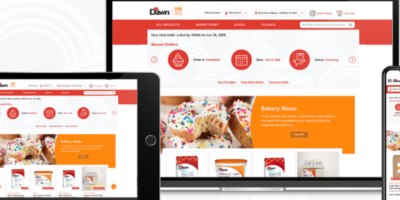
New know-how is driving a lot of at the moment’s channel shift in business-to-business gross sales and advertising because it speeds info alternate, product discovery and order entry on-line. However customer-facing know-how constructed across the calls for of programs somewhat, than the precise wants of the shopper, can negatively have an effect on an organization’s model, status and dependable following.
Megan Burns
“Regardless of how advanced the enterprise, buyer expertise at all times boils right down to a human being making an attempt to perform a purpose,” says Megan Burns, CEO of consulting firm Expertise Enterprises. “Eighty-four p.c of consumers say being handled like an individual, not a quantity, is necessary to profitable their enterprise.”
Burns will ship a keynote deal with, “Nice Buyer Expertise Isn’t Magic: How Techniques Drive Smiles on the World’s Most Buyer-Centric Corporations,” at B2B Subsequent, to be held in Chicago Sept. 30 – Oct. 2. An knowledgeable on buyer expertise administration with 20 years within the business, she has an inside view of how main corporations earn loyalty from the individuals they serve.
In an interview with B2BecNews, Burns shared the place she sees B2B corporations thriving, or lacking the mark, within the on-line buyer expertise they supply—and what they will do to enhance, proper now and sooner or later.
Q: What’s a very powerful factor that B2B corporations underestimate about making a world-class buyer expertise?
Burns: B2B corporations underestimate how typically they de-humanize prospects by referring to them as “customers” and “consumers” or when it comes to operate similar to “procurement” and “IT.” De-personalization is an issue since you threat ignoring—and thus failing to satisfy—prospects’ social and emotional wants—that are simply as necessary, generally extra, than their useful wants.
You additionally threat losing time on elements of the expertise that nobody cares about. In dozens of B2B analysis tasks, I’ve discovered prospects’ useful objectives nearly at all times turned out to be a lot less complicated than anticipated, whereas their emotional wants have been considerably extra nuanced. A mixture of qualitative and quantitative buyer analysis offers you essentially the most full, balanced, correct image of the people you’re making an attempt to serve.
In B2B, it’s hardly ever an enormous catastrophe that sends purchasers to the competitors. It’s ‘loss of life by a thousand cuts.’
Megan Burns, CEO
Expertise Enterprises
Q: What position does emotion play in fostering a compelling B2B buyer expertise?
Burns: Emotion hyperlinks the shopper’s previous expertise and future habits. When somebody is selecting a provider or deciding which channel to make use of, they assume again to comparable previous conditions. If working with an organization or channel gave them detrimental feelings—for instance, triggered them to overlook a deadline—they received’t wish to threat feeling that ache once more. However for those who made them really feel good, they’ll be extra inclined to offer you one other attempt.
Not all occasions from the previous matter equally, although. People keep in mind sturdy feelings greater than gentle ones, like a extremely dangerous expertise that turned somebody off ceaselessly or a extremely nice one which made them loyal for all times.
Q: What are the important thing parts of establishing a number one B2B buyer expertise?
Burns: Three issues:
♦ First, a transparent sense of what the shopper is making an attempt to perform. Take onboarding. Few prospects would say their purpose is to be “on-boarded”—they’re making an attempt to achieve a degree the place they will use your instruments to unravel their issues.
♦ Second, a design course of the place you iterate with prospects towards a last design. Buyer expertise design isn’t like math—there’s no proper or improper reply. It’s extra like a recreation of “you’re getting hotter, you’re getting colder.”
♦ Third, standards for evaluating the expertise when you’ve carried out it. Some elements might be captured with numbers, however deciding whether or not it’s good or dangerous is a extra advanced, nuanced and subjective course of.
Q: How do B2B corporations use journey mapping most successfully to determine buyer ache factors?
Burns: Base your journey maps on enter from front-line staff, who cope with prospects day by day, for essentially the most correct view of what individuals undergo—the great, the dangerous, and the ugly. Too many journey maps present what’s supposed to occur, or what executives assume occurs. It’s possible you’ll discover out that staff have been absorbing the brunt of consumers’ ache for them by workarounds or coordinating issues behind the scenes to cover simply how damaged your inside processes are.
However don’t focus solely on what’s improper. Staff have a wealth of perception into what’s working and may help you flip pockets of finest practices into a brand new, more practical customary for serving prospects.
Q: What’s the most important upside that B2B corporations miss when contemplating new investments in enhancing buyer expertise?
Burns: Some leaders assume that to get outcomes you want a mammoth overhaul of some system or course of. Others really feel that if a change received’t present an instantaneous impression on income, it’s not value doing. Each views are short-sighted. In B2B, it’s hardly ever an enormous catastrophe that sends purchasers to the competitors. It’s “loss of life by a thousand cuts.” Small, fixable hassles chip away on the notion that your model is useful and straightforward to work with.
Main companies take a parallel strategy. They work on a package deal of small modifications on the similar time they determine the large points. The outcome is a continuing stream of enchancment, little bursts of enjoyment that present prospects you have to enhance—and are working laborious to do it.
Registration for B2B Subsequent 2019 is open: Click on right here to register.
Study extra at: B2BNext.internet
Favourite




















